 |
| DINODIA PHOTOS / ALAMY |
|
Top: In Rajasthan, India, a shop sells
brightly patterned sunshade umbrellas,
which are still used in wedding and festival
processions such as this one above. |
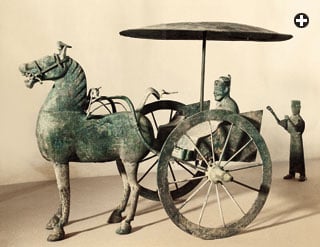 |
| ERICH LESSING / ART RESOURCE |
|
This bronze model of an umbrella-covered
sulky-like carriage from Gansu, China dates
to the second century ce. |
 n the title scene of the 1952 classic movie "Singin' in the Rain,"
Gene Kelly escorts his newfound love to her home, in the rain.
They share the shelter of his umbrella. He kisses her at her
door and then dances with his umbrella in the downpour until a
beat cop squelches his exuberance. Kelly folds the umbrella, hands
it to a passerby and walks off the scene. This sums up how most of
us today think of the umbrella: a practical item unworthy of notice
until it's raining.
n the title scene of the 1952 classic movie "Singin' in the Rain,"
Gene Kelly escorts his newfound love to her home, in the rain.
They share the shelter of his umbrella. He kisses her at her
door and then dances with his umbrella in the downpour until a
beat cop squelches his exuberance. Kelly folds the umbrella, hands
it to a passerby and walks off the scene. This sums up how most of
us today think of the umbrella: a practical item unworthy of notice
until it's raining.
It was not always so. Behind this prosaic present is a powerful
past. I first encountered a much different sort of umbrella in India.
In a market in the western province of Rajasthan, I purchased a
large, heavy bamboo umbrella whose cotton fabric was all colorful
cutwork, embroidered with animals. It could not possibly have kept out the rain.
Years later, I found out I owned a traditional wedding umbrella: At the head of a
procession of his relatives, the groom rides to his wedding on a white horse while an
attendant holds this sort of large, ornate umbrella over him. This umbrella signifies
that, at least for this one day, the groom is a king.
The royal umbrella, carried by an attendant, not only shaded the king from the sun,
but also symbolized his power in procession, battle and the hunt. For millennia, it has
been a common symbol among rulers in a huge portion of the world that includes the
Middle East, Egypt and North Africa, sub-Saharan Africa, Persia, South and Southeast
Asia, China, Japan and Korea. The royal umbrella flourished in Muslim, Hindu, Confucian,
Buddhist, animist and some Christian courts. Rulers sometimes bestowed umbrellas
on high officials and generals as a visible recognition of their loyalty.
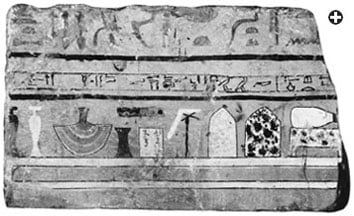
|
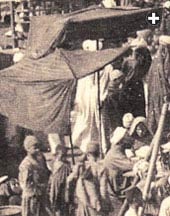
|
|
H.E. WINLOCK, EXCAVATIONS AT DEIR EL BAHRI, 1911-1931, PLATE 13
|
CONSTANTINE AND ADELPHI ZANGAKI / LIBRARY OF CONGRESS
|
|
Just right of center, on the lower register
of this fragment of a fresco excavated
from the 14th-century bce tomb of Queen
Nefertiti, there appears a sunshade
umbrella, supported by a pair of crossed
sticks on a pole, with an additional hanging
flap. Right: This detail of an albumen print,
dated between 1860 and 1890, shows a
Cairo market in which vendors are using
sunshades of a nearly identical design. |
The royal umbrella was not an idea that spread from invention in one place—in fact
it was invented at least four times. The earliest recorded examples are from Egypt's
Fifth Dynasty, from about 2500 to 2400 bce.
Decorations on tombs and temples from
these times portray a flat, square, crossed-stick umbrella shading gods and kings. The
hieroglyph for umbrella signified sovereignty as well as the "shadow," or influence, of
a person. Thus the umbrella augmented a pharaoh's shadow. The
history of the square umbrella is long, and, although it is no longer
associated with kings, such umbrellas can still be found shading
market carts in Egypt.
 he second invention of the umbrella took place in China. A
classical text titled The Rites of Zhou from 400 bce describes
the construction and use of a round, segmented, silk umbrella
whose function was to shade ceremonial chariots. Somewhat later
reliefs illustrate such an umbrella, and archeologists have excavated
several complex brass castings used to hold the ribs of such umbrellas.
This kind of royal umbrella remained a symbol of Chinese royal privilege,
and it appears in countless court paintings. When Marco Polo
arrived at the court of Kublai Khan in 1275, he found the Mongols had
adopted many Chinese customs, including the bestowal of a special
umbrella on the highest commanders in the army:
he second invention of the umbrella took place in China. A
classical text titled The Rites of Zhou from 400 bce describes
the construction and use of a round, segmented, silk umbrella
whose function was to shade ceremonial chariots. Somewhat later
reliefs illustrate such an umbrella, and archeologists have excavated
several complex brass castings used to hold the ribs of such umbrellas.
This kind of royal umbrella remained a symbol of Chinese royal privilege,
and it appears in countless court paintings. When Marco Polo
arrived at the court of Kublai Khan in 1275, he found the Mongols had
adopted many Chinese customs, including the bestowal of a special
umbrella on the highest commanders in the army:
An officer who holds the chief command of 100,000 men, or
who is the general-in-chief of a great host, is entitled to a [gold]
tablet that weighs 300 saggi…. Every one, moreover, who holds a tablet of this
exalted degree is entitled, whenever he goes abroad, to have a little golden
canopy, such as is called an umbrella, carried on a spear over his head in token of
his high command.
From China, the royal umbrella spread to Japan and Korea. In Japan, it ceased to be
a royal prerogative within a few centuries, and it found widespread use throughout
society. Woodblock prints and paintings of the 18th century often feature a theme of
ordinary people under umbrellas in the rain. Korea, however, could not have been more
different. There the umbrella remained a strictly royal
symbol. Because Korean artwork never pictured the
emperor, his presence was signified by a horse with an
empty saddle, shaded by the royal umbrella.
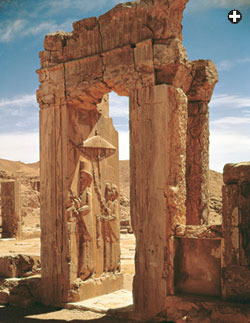 |
| BRIDGEMAN ART LIBRARY |
|
On a doorway that led to the fifth-century bce
throne room in Persepolis, Iran,
a relief shows King Xerxes i shaded by an umbrella. Some two centuries
earlier, Assyrian artists showed King Ashurbanipal, below, shaded by an
umbrella with a hanging flap that resembles those depicted in Egypt. |
 |
| MUSÉE DU LOUVRE / BRIDGEMAN ART LIBRARY |
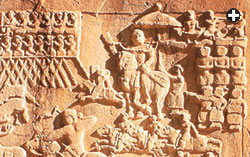 |
| ALINARI / ART RESOURCE |
|
Ruling in Persia more than 1000 years
after Xerxes i,
Khosrau ii was depicted at
Taq-e Bostan watching a hunt from under
a royal umbrella. |
 he third invention of the royal umbrella was
in Mesopotamia, centuries after the Egyptian
square parasol. In bas-reliefs at Nineveh, shading
King Ashurbanipal of Assyria, who ruled from
668 to 627 bce, is a round and pointed umbrella. From
there, the royal umbrella drifted both west and east. In
Greece, it lost its association with kingship and became
particularly associated with women. Aristophanes' play
Women at Thesmophoria satirized Athenian attitudes
toward both women and men. In the final scene, the
women boast of their steadfastness:
he third invention of the royal umbrella was
in Mesopotamia, centuries after the Egyptian
square parasol. In bas-reliefs at Nineveh, shading
King Ashurbanipal of Assyria, who ruled from
668 to 627 bce, is a round and pointed umbrella. From
there, the royal umbrella drifted both west and east. In
Greece, it lost its association with kingship and became
particularly associated with women. Aristophanes' play
Women at Thesmophoria satirized Athenian attitudes
toward both women and men. In the final scene, the
women boast of their steadfastness:
And then there's your omission
To keep up your old tradition
As the women of the race have always done:
We maintain our ancient craft
With the shuttle and the shaft
And the parasol—our shield against the sun.
These attitudes carried west to Rome, where the
umbrella was deemed too effeminate for men's use.
Juvenal, for example, wrote of a "pretty fellow, to have
presents sent to him of green sunshades." On Roman
coins, the umbrella appeared only twice, both times in
association with the Middle East: One coin was issued
around 40 ce
in Palestine and the other between 218
and 222 ce
by Emperor Heliogabalus, who was from
Syria. Overall, the Roman Empire passed on to Europe
no legacy of a royal umbrella.
East of its Mesopotamian origins, however, the royal
umbrella flourished. Bas-reliefs on the walls of Persepolis,
dating from 500 bce,
show the king seated or walking under his royal umbrella.
Later, from the third to seventh centuries, the Sassanians
ruled the next great empire that included Persia.
From their original homeland on the borders of China,
they migrated west across the Central Asian steppe, and they either brought with
them the Chinese tradition of the royal umbrella or they adopted the Persian royal
umbrella when they arrived. In either case, Sassanian kings ruled beneath royal
umbrellas, as shown on the rock-cut bas-relief at Taq-e Bostan, from about 380
ce.
In Constantinople, founded in 330 ce,
umbrellas appear prominently in Christian
artwork. With the rise of Islam in the seventh century, it becomes more difficult
to document the uses of royal umbrellas because most Islamic art favored
geometry and calligraphy over depictions of people. In Abbasid Baghdad, from the
eighth to the 13th centuries, courtiers and scholars wrote on mathematics, astronomy,
history, medicine and philosophy, but nothing about day-to-day court ritual.
It is from later texts in Egypt that we get some insight. Paula Sanders of Rice
University has analyzed three texts from Egypt that describe processions and court
ritual under the 10th- and 11th-century Fatimids, whose caliphs appeared in procession
under a royal umbrella—a practice that they attributed to the earlier Abbasid
dynasty. For the whole of the Fatimid period, factional power was constantly
shifting, and the caliph selectively bestowed the right to display an umbrella,
which signaled the recipient's support and commitment to the caliph.
 |
In sub-Saharan West Africa, the royal umbrella frequently appears in both
Islamic and non-Islamic kingdoms. There, it is possible that the umbrella came
south from Islamic Tunisia and Morocco, along the trade routes across the Sahara.
It is equally possible that it was indigenous—and thus yet another independent,
parallel invention. Umbrellas were part of the king's regalia in all major kingdoms
of West Africa, including Ashanti, Benin, Sokoto and Dahomey. In European
drawings from the 18th century and in early photographs
from the 19th century, kings of these states conduct royal
business from beneath a large royal umbrella.

|
| MARC CHARMET / THE ART ARCHIVE |
|
Prominently displaying large, colorful
umbrellas, this engraving dated 1820 is
titled "English Embassy in Komassi,
West Africa."
|
Rulers in East Africa, too, adopted the royal umbrella. It
is prominent in texts and frescoes in Ethiopia that date to
the 1200's, and its use continued in an unbroken tradition
well into the 20th century. Royal umbrellas were also found
in courts on the East African coast, where it is likely that
they spread via Muslim trade ties with Egypt and the lands
of the Arabian Peninsula. Ibn Battuta, the most traveled man
of the Middle Ages, reached East Africa in the 14th century.
At Mogadishu, he wrote that the king entertained him well,
feeding him delicacies from the Middle East. During processions,
Ibn Battuta noted that royal umbrellas protected the
king from the sun:
Over his head were carried four canopies of colored
silk, with the figure of a bird in gold on the top of
each canopy…. In front of him were sounded drums
and trumpets and fifes, and behind him were the
commanders of the troops, while the qadi, the doctors
of law, and the sharifs walked alongside him.
Later, both Ottoman Turkish and Safavid Persian court paintings also show royal umbrellas.

|
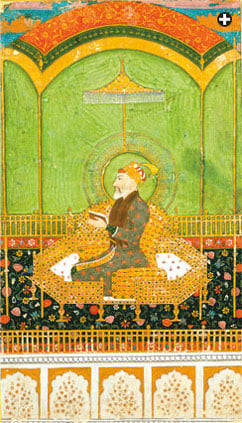
|
MUSEO NAZIONALE D'ARTE ORIENTALE / GIRAUDON /
BRIDGEMAN ART LIBRARY
|
GIANNI DAGLI ORTI / THE ART ARCHIVE / ALAMY
|
|
Both this Chinese-influenced Tibetan
depiction of the Buddha, left, and
this Muslim Mughal miniature of
Shah Jahan, right, date from the
17th century, and both show their
subjects seated under umbrellas. |
 he fourth invention of the royal umbrella was in India, where the earliest
he fourth invention of the royal umbrella was in India, where the earliest
evidence is from Buddhist literature and reliefs dating back to about 300
bce.
In these early texts, when Siddhartha Gautama left behind his royal
upbringing to meditate on the sufferings of the world, he was shaded by a cobra's
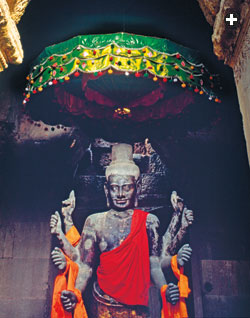 |
| JON BOWER CAMBODIA / ALAMY |
|
Hindus, too, adopted the umbrella
in both religious and royal settings.
At Angkor, Cambodia, a statue above depicts the Hindu god Vishnu, and a
relief detail, below, depicts a battle in
which a ruler fights from beneath
an umbrella. |
hood, a tree, or an umbrella. In particular,
the umbrella became a symbol of
his successful search for enlightenment,
and in these texts he is
referred to as the "Buddha of the
White Umbrella." Early Buddhist
sculpture does not portray the Buddha,
but rather objects associated
with him: An empty platform and
the bodhi tree, a cobra or an honorific
umbrella signify his presence.
After the Buddha's death, his
followers sent small portions of his
ashes to other groups of followers,
who built mounds over the ashes.
Several umbrellas mounted on a
single shaft topped these mounds,
and these became known as stupas,
such as those built at Sanchi in
Central India around 100 bce.
The reliefs on the stupas at Sanchi
also show kings, under royal
umbrellas, arriving in
procession to honor the
Buddha. (Incidentally, multiple
umbrellas on the tops
of stupas are the origin of
the Chinese pagoda, which
added walls and made the
multiple umbrella into an
architectural form.)
 |
| STEWART GORDON |
Also in the earliest Hindu writings, dating to the first four centuries of
our era, umbrellas regularly shade kings. In this quotation from the Ramayana,
Ram's father contemplates his life:
In my fathers' footsteps treading I have sought the ancient path,
Nursed my people as my children, free from passion, pride and wrath,
Underneath this white umbrella, seated on this royal throne,
I have toiled to win their welfare and my task is almost done!
 |
The royal umbrella continued as an unbroken tradition for all Indian kings for the
next millennium and a half. The artwork of the southern Islamic kingdoms makes
it clear that both Muslim and Hindu kings used the royal umbrella. For example, the
Battle of Talikota, in 1386, pitted the Hindu king of Vijayanagar against the Muslim sultans
of Bijapur, Golconda, Bidar and Ahmadnagar. A contemporary painting shows the
adversaries approaching the battle under their respective royal umbrellas. Throughout
the British colonial period, India's princes ruled from beneath royal umbrellas—some
of which were by then manufactured in London. When he visited India in 1911, King
George of England walked beneath a royal umbrella.
 ometime around 800 ce,
the royal umbrella began to flourish in Southeast Asia,
adopted by kings in Cambodia, Laos, Burma, Thailand, Vietnam and Java. The
custom may have come from India or China, as both cultures strongly influenced
the region at the time. A charming story from 12th-century Burma illustrates the
umbrella's symbolic power: The king was unable to choose his successor from among
his five sons. One night, he ordered his royal umbrella set up, and he commanded that
his sons sleep in a circle around it. The successor was chosen when the umbrella fell
in one son's direction, and in the chronicles he became known as "the king whom the
umbrella placed on the throne."
ometime around 800 ce,
the royal umbrella began to flourish in Southeast Asia,
adopted by kings in Cambodia, Laos, Burma, Thailand, Vietnam and Java. The
custom may have come from India or China, as both cultures strongly influenced
the region at the time. A charming story from 12th-century Burma illustrates the
umbrella's symbolic power: The king was unable to choose his successor from among
his five sons. One night, he ordered his royal umbrella set up, and he commanded that
his sons sleep in a circle around it. The successor was chosen when the umbrella fell
in one son's direction, and in the chronicles he became known as "the king whom the
umbrella placed on the throne."
 |
 |
GAHOE MUSEUM / BRIDGEMAN ART LIBRARY
|
MELVYN LONGHURST / ALAMY
|
|
From Korea, a religious painting uses an umbrella,
left, as does a modern statue of King Naresuan
in Thailand, right. |
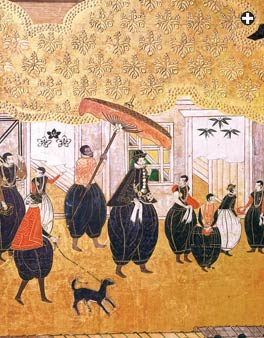 |
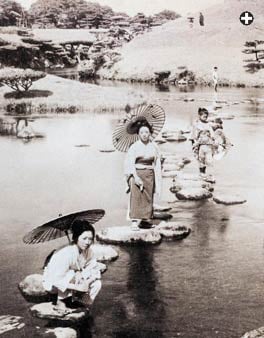 |
|
MUSÉE GUIMET / GIANNI DAGLI ORTI / THE ART ARCHIVE / ALAMY
|
THE PRINT COLLECTOR / ALAMY
|
|
Left: Arriving in Japan in the 17th
century, the Portuguese ambassador was
depicted under an elaborate umbrella.
Right: Japan was one of the few places
where umbrellas became objects of fashion
from an early time, and today the bamboo
parasol remains a national folkloric symbol. |
Two of the most famous early sites in Southeast
Asia, Borobudur in Central Java, which dates from
the eighth and ninth centuries, and Angkor in Cambodia,
dating from the 10th to 12th centuries, are
both replete with umbrellas. Among the nearly 3000
reliefs adorning Borobudur, umbrellas identify kings,
nobility and famous figures from the Buddha's life.
At Angkor, a huge bas-relief portrays a battle
between the Cambodians and the Champa kingdom
(in current-day Vietnam). On it, generals and noble
advisors all have umbrellas, supporting speculation
that, as in Fatimid Egypt, bestowal of an umbrella
cemented loyalty. The king, however, has more
umbrellas surrounding him than anyone else—15 in
all—complete with an entourage of umbrella carriers.
In Burma as in India, the tradition continued
into the 19th century. Dutch and British emissaries
observed the king shaded by umbrellas in processions,
and they negotiated with the king while he was seated
under his royal umbrella. In 1867, the English resident
at the Burmese court and his wife were granted the
privilege of an umbrella, likely a political move aimed
at holding off a British takeover. (It was not enough,
however, and the British did take over Burma in 1885.)
Thailand, which remained more or less independent,
continued its tradition of the royal umbrella until
recent decades, and in 1967, Jacqueline Kennedy, wife
of us
president John F. Kennedy, was granted a ceremonial
umbrella when she visited Thailand.
 |
| PHOTOSERVICE ELECTA MONDADORI / ART RESOURCE |
|
Although Europe never fully embraced the royal
umbrella, the late-18th-century artist Laurent Pechaux
painted one over Pope Gregory xi, above;
the 17th-'century French artist Charles Le Brun painted two
above a chancellor, below left, and an 1894 fashion print
from France shows a lady's parasol tensioned by
springy ribs of newly available lightweight steel. |

|

|
| ERICH LESSING / ART RESOURCE |
PHOTOS12 / ALAMY |
 he earliest evidence of an umbrella in Europe
comes from the Utrecht Psalter, which is generally dated to the 900's. One of its
illustrations shows an angel holding an umbrella over King David. However, it is
not until the 13th century that scholars have found evidence of a royal umbrella, and then
only in Italy, which at that time was receiving much culture and learning from Islamic
Spain, including medicine, philosophy, cuisine, music and the game of chess. Venice, with
its close trading ties to the Islamic world, adopted the umbrella for the doge when he was
in a procession, and so did the pope in Rome. But the royal umbrella just never caught on
in Europe. In addition to its cooler climate, the influence
of the Crusades led courts by 1300 to regard the royal
umbrella as a foreign symbol, one used by enemies. By the
end of the 18th century, even the papal umbrella had been
replaced by a four-cornered, flat canopy.
he earliest evidence of an umbrella in Europe
comes from the Utrecht Psalter, which is generally dated to the 900's. One of its
illustrations shows an angel holding an umbrella over King David. However, it is
not until the 13th century that scholars have found evidence of a royal umbrella, and then
only in Italy, which at that time was receiving much culture and learning from Islamic
Spain, including medicine, philosophy, cuisine, music and the game of chess. Venice, with
its close trading ties to the Islamic world, adopted the umbrella for the doge when he was
in a procession, and so did the pope in Rome. But the royal umbrella just never caught on
in Europe. In addition to its cooler climate, the influence
of the Crusades led courts by 1300 to regard the royal
umbrella as a foreign symbol, one used by enemies. By the
end of the 18th century, even the papal umbrella had been
replaced by a four-cornered, flat canopy.
 |
Later, there were exceptions. Portuguese and Spanish colonial traders returned
from Asia with umbrellas, and around the 16th century those lost their royal status
and became occasional items of courtly fashion. Though Mary Queen of Scots owned
one in 1562, and the term "ombrello" appeared in an Italian–English dictionary
of 1598, they were unknown in the larger society. It was only in the 18th century that
umbrellas caught on as a fashion item—and that still as sunshades made of cotton
or thin leather, of no use in the rain. In the 19th century, these ladies' parasols went
through almost yearly fashion shifts.
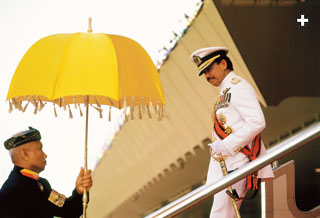 |
| ASIA IMAGES GROUP / ALAMY |
|
In modern times, Sultan Hassanal Bolkiah of Brunei, above,
used a yellow umbrella at a ceremony on his birthday, and a traditional ruler
in Ghana, below, used several in his party for a corn festival parade
in Accra. The large umbrellas in the background resemble the ones
depicted in the early 19th century. |
 |
| OLIVER ASSELIN / ALAMY |
The water-resistant umbrella first appeared in England in the late 18th
century to protect clerics and officials during outdoor duties. They were heavy,
stiff and slow to dry. They leaked, their whalebone ribs rotted quickly, and the folding
mechanisms often failed. All umbrellas, whether to protect from rain or sun,
were deemed too "feminine" for ordinary Englishmen.
With the Industrial Revolution
came lightweight steel and, with that, a drive to make a light, foldable,
rainproof umbrella. Inventors in Europe and America filed hundreds of patents
for folding mechanisms, rib arrangements and even provisions for concealing
swords or pistols in umbrellas. Following dozens of minor improvements, the
modern umbrella began to emerge, and by 1910, Britain was exporting more than three
million a year—many to Asia. Germany and Italy were Britian's chief competitors, making
cheaper models.
 his long and complicated history of the umbrella shows that it did not simply
"diffuse" from one place of invention outward to a wider world. It was invented at
least four times, and it moved in unpredictable ways, sometimes never leaving its
country of origin, like the Egyptian square umbrella, and other times moving into a society
that completely changed its meanings and uses. Greece, Rome and 18th-century England
deemed the umbrella "feminine," while the Japanese umbrella was acceptable for both
men and women but spread from royal to general use.
his long and complicated history of the umbrella shows that it did not simply
"diffuse" from one place of invention outward to a wider world. It was invented at
least four times, and it moved in unpredictable ways, sometimes never leaving its
country of origin, like the Egyptian square umbrella, and other times moving into a society
that completely changed its meanings and uses. Greece, Rome and 18th-century England
deemed the umbrella "feminine," while the Japanese umbrella was acceptable for both
men and women but spread from royal to general use.
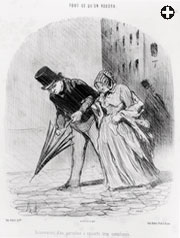
|
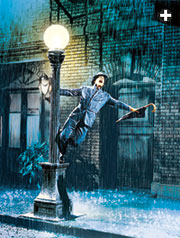
|
MUSEE DE LA VILLE DE PARIS /
MUSEE CARNAVALET / GIRAUDON /
BRIDGEMAN ART LIBRARY |
THE ART ARCHIVE |
|
The unreliability of Europe's early steel
umbrellas caught the eye of French satirist
Daumier, left, but by the time Gene
Kelly turned his bumbershoot into an iconic
Hollywood dance prop in "Singin' in the
Rain," right, the waterproof umbrella had become
plain and practical, offering little hint of its
symbolic and powerful past. |
Several points about this complicated
process seem significant. Rulers everywhere
seek symbols that enhance dignity,
visibility and the loyalty of subjects. They
were willing to experiment with new
symbols, such as the royal umbrella. Several
sorts of travelers, such as emissaries, traders,
monks, learned men and professional
soldiers, brought back, often over long distances,
information about royal symbols. For
centuries, the royal umbrella was part of a
shared courtly world that stretched from
Asia to Africa and Spain. It was part of a
familiar courtly scene to those who traveled
for political reasons, business or advancement.
The royal umbrella was frequently a
potent political symbol. Because it was tied to
no religion, region, language or ethnic group,
kings could use it to rally disparate groups.
The umbrella was also, however, granted
to a select few at court. When the recipient
traveled under it, every observer knew of his
personal ties to the king. It was a public commitment of personal loyalty, important in times
of factional strife and threats to the throne—a situation all too frequent among kings.
Today, the world of the royal umbrella is almost entirely gone, but with imagination
and the memory of history, we can recall the lavish decorations, dignified processions and
royal associations it carried—every time it rains and we pop open our umbrella.

 |
Stewart Gordon is a senior research scholar at the Center for South Asian Studies, University of Michigan. His recent books include When Asia was the World (Da Capo, 2008) and Routes: How the Pathways of Goods and Ideas Shaped Our World (University of California Press, forthcoming 2012). |